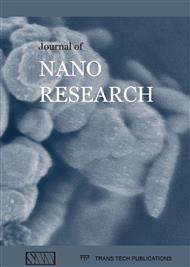[1]
J. Kreuter, Nanoparticle–based dmg delivery systems, J. Control. Release. 16 (1991) 169–176.
DOI: 10.1016/0168-3659(91)90040-k
Google Scholar
[2]
W. Thielemans, M.N. Belgacem, A. Dufresne, Starch nanocrystals with large chain surface modifications, Langmuir. 22 (2006) 4804–4810.
DOI: 10.1021/la053394m
Google Scholar
[3]
K. Eleana, G. Costas. Biliaderis, Physical properties of starch nanocrystal–reinforced pullulan films, Carbohydr. Polym. 68 (2007) 146–158.
DOI: 10.1016/j.carbpol.2006.07.021
Google Scholar
[4]
V. Lenaerts, I. Moussa, Y. Dumoulin, F. Mebsout, F. Chouinard, P. Szabo, M.A. Mateescu, L. Cartilier, R. Marchessault, Cross–linked high amylose starch for controlled release of drugs: recent advances, J. Control. Release. 53 (1998) 225–234.
DOI: 10.1016/s0168-3659(97)00256-3
Google Scholar
[5]
H. Angellier, S. Molina–Boisseau, M.N. Belgacem, A. Dufresne, Surface chemical modification of waxy maize starch nanocrystals, Langmuir. 21 (2005) 2425–2433.
DOI: 10.1021/la047530j
Google Scholar
[6]
X. Suyao, T. Chunyi,L. Xuanming, Preparation of folate–conjugated starch nanoparticles and its application to tumor–targeted drug delivery vector, Chinese Sci. Bull. 51 (2006) 1693–1697.
DOI: 10.1007/s11434-006-2039-7
Google Scholar
[7]
T.L. Levien, D. E Baker, Reviews of levomethadyl acetate and degradable starch microspheres, Hosp Pharm, 28 (1993), 1214–1222.
Google Scholar
[8]
M.J. Santander–Ortega, T. Stauner, B. Loretz, J.L. Ortega–Vinuesa, D. Bastos–Gonzalez, G. Wenz, U.F. Schaefer, C.M. Lehr, Nanoparticles made from novel starch derivatives for transdermal drug delivery, J. Control. Release. 141 (2010) 85–92.
DOI: 10.1016/j.jconrel.2009.08.012
Google Scholar
[9]
W.L. Kerr, C.D.W. Ward, K.H. McWatters, A.V.A. Resurreccion, Milling and particle size of cowpea flour and snack chip quality, Food Res. Int. 34 (2001) 39–45.
DOI: 10.1016/s0963-9969(00)00126-5
Google Scholar
[10]
R. Wongsagona, S. Shobsngobb, S. Varavinita, Preparation and physicochemical properties of dialdehyde tapioca starch, Starch–Stärke. 57 (2005) 166–172.
DOI: 10.1002/star.200400299
Google Scholar
[11]
R. Hoover, Acid–Treated starches, Food Rev. Int. 16 (2000) 369–392.
Google Scholar
[12]
J.Y. Kim, D.J. Park, S.T. Lim, Fragmentation of Waxy Rice Starch Granules by Enzymatic Hydrolysis, Cereal Chem. 85 (2008) 182–187.
DOI: 10.1094/cchem-85-2-0182
Google Scholar
[13]
G. Zhou, Z. Luo, X. Fu, Preparation and characterization of starch nanoparticles in ionic liquid–in–oil microemulsions system, Ind. Crop. Prod. 52 (2014) 105–110.
DOI: 10.1016/j.indcrop.2013.10.019
Google Scholar
[14]
Q. Sun, M. Gong, Y. Li, L. Xiong, On the validity of the Boltzmann–BGK model through relaxation evaluation, Acta Mech. Sinica. 111 (2014) 133–143.
DOI: 10.1007/s10409-014-0017-x
Google Scholar
[15]
A.P. Mathew, A. Dufresne, Morphological Investigation of Nanocomposites from Sorbitol Plasticized Starch and Tunicin Whiskers, Biomacromolecules 3 (2002) 609–617.
DOI: 10.1021/bm0101769
Google Scholar
[16]
S. Chakraborty, B. Sahoo, I. Teraoka, Solution properties of starch nanoparticles in water and DMSO as studied by dynamic light scattering, Carbohydr. Polym. 60 (2007) 475–481.
DOI: 10.1016/j.carbpol.2005.03.011
Google Scholar
[17]
L. H.Pulkki, Particle size in relation to flour characteristics and starch cells of wheat, Cereal Chem. 15 (1938) 749–765.
Google Scholar
[18]
S. Bel Haaj, A. Magnin, C. Pétrier, S. Boufi, Starch nanoparticles formation via high power ultrasonication, Carbohydr. Polym. 92 (2013) 1625–1632.
DOI: 10.1016/j.carbpol.2012.11.022
Google Scholar
[19]
F. Giezen, R., Jongboom, K., Gotlieb, A. Boersma, Biopolymer nanoparticles. U.S. Patent WO 00/69916, January 25, (2000).
Google Scholar
[20]
M. Lamanna, N.J. Morales, N.L. García, S. Goyanes, Development and characterization of starch nanoparticles by gamma radiation: Potential application as starch matrix filler, Carbohydr. Polym. 97 (2013) 90–97.
DOI: 10.1016/j.carbpol.2013.04.081
Google Scholar
[21]
D. Liu, Q. Wu, H. Chen, P.R. Chang, Transitional properties of starch colloid with particle size reduction from micro– to nanometer, J. Colloid Interface Sci. 339 (2009) 117–124.
DOI: 10.1016/j.jcis.2009.07.035
Google Scholar
[22]
W.L. Kerr, C.D.W. Ward and K.H. McWatters.Milling and particle size of cowpea flour and snack chip quality, Food Res. Int. 34 (2001) 39–45.
DOI: 10.1016/s0963-9969(00)00126-5
Google Scholar
[23]
L. Vertuccio, G. Gorrasi, A. Sorrentino and V. Vittoria, Nano clay reinforced PCL/starch blends obtained by high energy ball milling, Carbohydr. Polym. 75 (2009) 172–179.
DOI: 10.1016/j.carbpol.2008.07.020
Google Scholar
[24]
X. Ma, R. Jian, P.R. Chang, J. Yu, Fabrication and Characterization of Citric Acid–Modified Starch Nanoparticles/Plasticized–Starch Composites, Biomacromolecules. 9 (2008) 3314–3320.
DOI: 10.1021/bm800987c
Google Scholar
[25]
D. LeCorre, J. Bras, A. Dufresne, Starch Nanoparticles: A Review, Biomacromolecules. 11 (2010) 1139–1153.
Google Scholar
[26]
Z.Q. Huang, J.P. Lu, X.H. Li, Z.F. Tong, Effect of mechanical activation on physico–chemical properties and structure of cassava starch, Carbohydr. Polym. 68 (2007) 128–135.
DOI: 10.1016/j.carbpol.2006.07.017
Google Scholar
[27]
T.Y. Liu, Y. Ma, S.F. Yu, J. Shi, S. Xue, The effect of ball milling treatment on structure and porosity of maize starch granule, Innov. Food Sci. Emerg. 12 (2011) 586–593.
DOI: 10.1016/j.ifset.2011.06.009
Google Scholar
[28]
H.Y. Kim, S.S. Park, S.T. Lim, Preparation, characterization and utilization of starch nanoparticles, Colloid. Surface. B. 126 (2015) 607–620.
Google Scholar


